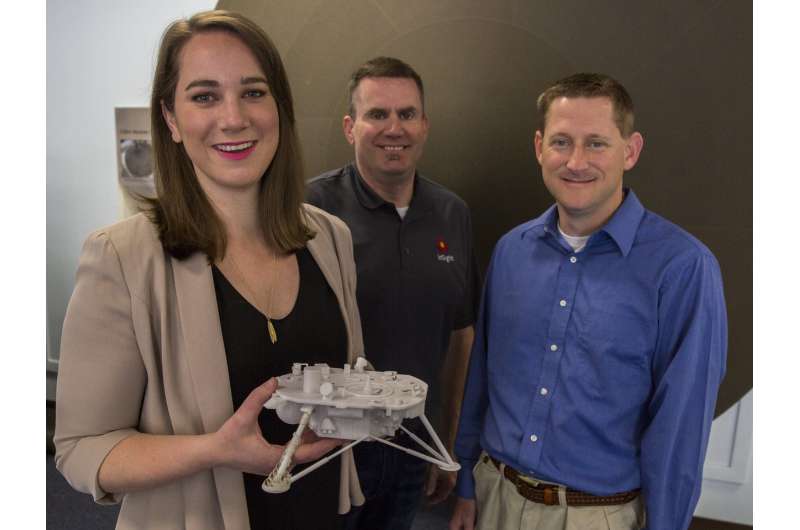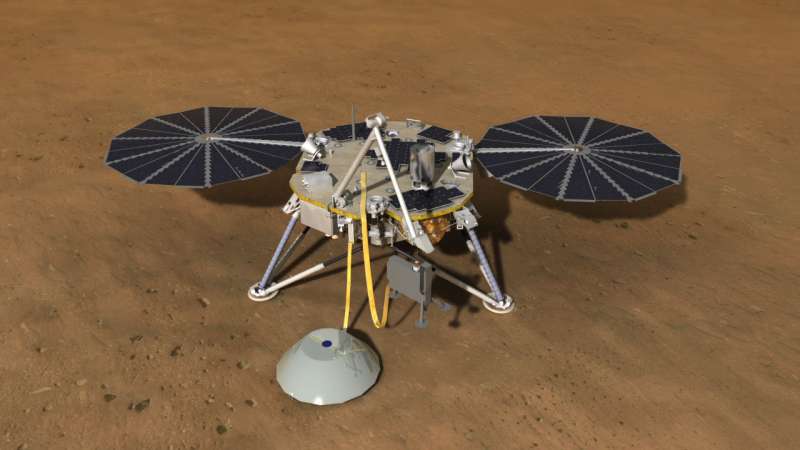Surviving the inferno of entry, descent and landing

Anticipation is building as preparations are well underway for the launch of NASA's next Mars mission, InSight. But before the roar of the rocket lifting off from Vandenberg Air Force Base has subsided, a NASA team will be hard at work preparing for the lander's eventual plunge through the Martian atmosphere.
Experts from NASA's Langley Research Center are key to providing modeling and computer simulations, which will be used by the InSight entry, descent and landing (EDL) team led by NASA's Jet Propulsion Laboratory along with Lockheed Martin Space and NASA's Ames Research Center.
Since early missions, such as Viking in 1976, Langley has played a central role in EDL simulations. The Langley group, led by Rob Maddock with Carlie Zumwalt, Alicia Dwyer Cianciolo, and Daniel Litton, is continuing that job today, building on previous projects including the Mars Science Laboratory, one of the largest and most complicated landings so far, and Phoenix, which is very similar to InSight.
"EDL has historically been a NASA Langley role in missions, ever since Viking, we've been known as 'the center' for EDL simulations," Maddock said.
And it's not an easy job. It's difficult to land on other planets, there are a lot of factors, and EDL performance assessment seeks to accurately predict what conditions will be like.
"We run simulations given all of the unknowns so that we can safely land where we want to," Maddock said. "The atmosphere is the biggest uncertainty."
The team has been running through as many possible scenarios as possible, using unique simulations first developed during the 1960s that have been validated and updated with experience. After launch, however, they will be able to verify their models against the actual performance.
During the six-month flight to Mars, the team will acquire data allowing them to add current conditions to their models and simulations, replacing some of the unknowns and estimates. There are opportunities to make adjustments to the trajectory and the flight software starting about a month after launch all the way up to entry into the Martian atmosphere. The data collected during flight analyses will help inform the decision to make any potential modifications.
InSight's launch period is May 5 through June 8, 2018. Whichever date the launch occurs, InSight's landing on Mars is planned for Nov. 26, 2018, around 3 p.m. EST.
The team will support operations at landing. EDL begins when the spacecraft arrives about 80 miles above the surface of Mars and ends after about six minutes with the lander safe on the ground.
For InSight, this phase will be very similar to NASA's Phoenix Mars Lander with a few key differences. InSight will enter the atmosphere at a higher velocity than Phoenix and has more mass. It will also land at a higher elevation so it has less atmosphere to use for deceleration, and the area is prone to dust storms. To address these challenges, InSight uses a thicker heat shield and its parachute will open at higher speed with stronger suspension lines.

After landing, the EDL team's job is not over. They will complete what they call 'reconstruction.'
"We will take the data (acceleration, inertial measurement unit, trajectory) and rebuild what happened during the actual landing to try and update our simulations and build better predictions," Maddock said.
NASA's Interior Exploration using Seismic Investigations, Geodesy, and Heat Transport (InSight) lander will study the deep interior of Mars to learn how all rocky planets formed, including Earth and its moon. The lander's instruments include a seismometer to detect marsquakes and a probe that will monitor the flow of heat in the planet's subsurface.
Provided by NASA





















